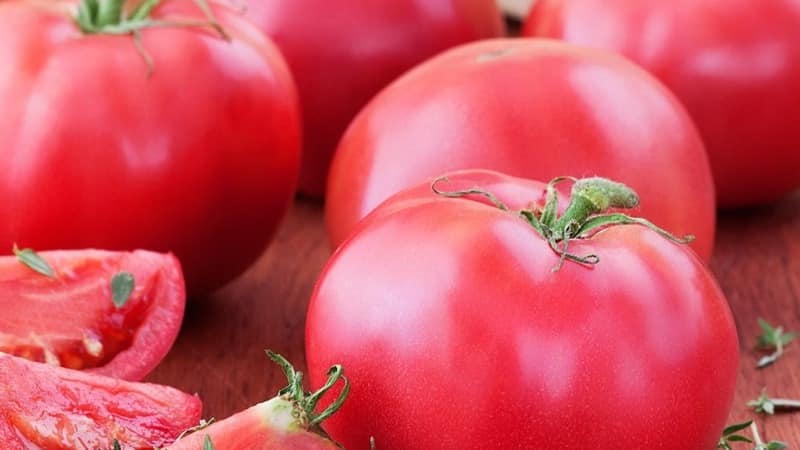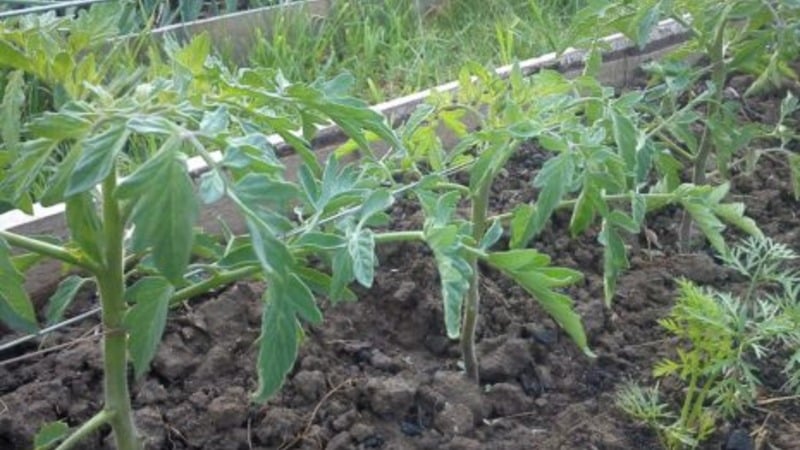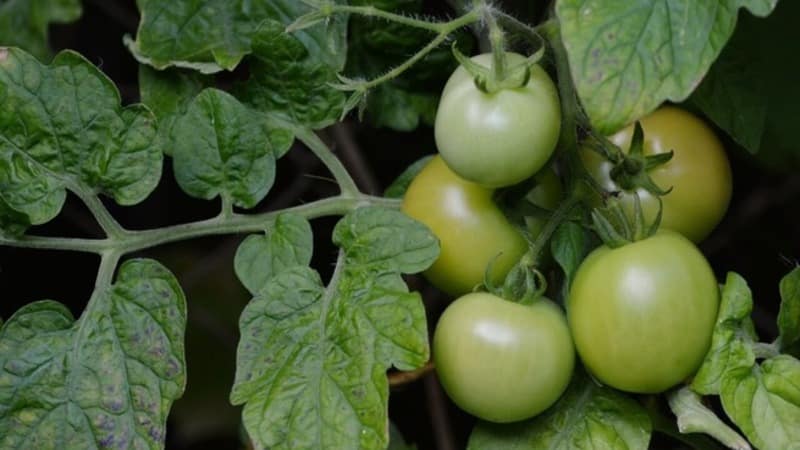Not capricious to care for, but at the same time rich in yield, the “Pretty” tomato: photos, reviews and growing secrets
Culinary use is an important factor when choosing a variety for your site. Many people want to grow not only summer tomatoes, but also make winter preparations. Tomato Pretty is a universal option for summer and winter culinary masterpieces. Ripe vegetables are distinguished by excellent taste and rich vitamin composition. Tomatoes look great not only in colorful photographs, but also on any holiday table.
Characteristics and description of the variety
The cute one has excellent adaptation to sudden cold snaps and tolerates rain and drought well. The formation of ovaries occurs in any weather; each cluster bears 5-7 fruits. Included in the State Register of Breeding Achievements.

Distinctive features
The type is determinate, low-growing, height 50-60 cm. moderate foliage, medium-sized leaves, dark green.
An early ripening variety, 95-110 days pass from the moment of sowing the seeds to full ripening.
The productivity is high, 3 kg of fruits are harvested from 1 seedling, provided that 3-4 plants are planted per 1 square meter. m.
It is characterized by increased resistance to the main diseases of the nightshade family. Recommended for cultivation in open ground and in greenhouse conditions.
The culture does not need to remove the stepsons, but tying it to the support is necessary. When vegetables ripen, fruitful branches cannot support their weight.
Fruit characteristics
Average weight 150-200 g, round shape, deep pink color. The taste is sweet, the flesh is juicy and meaty.There are 6 seed chambers, a lot of seeds. The peel is dense and not prone to cracking.
The purpose of tomatoes is universal: they are excellent for fresh consumption and for winter preparations. They look especially good in whole-fruit canning. Vegetables are processed into tomato products, resulting in excellent juices and ketchups.
Thanks to their thick skin, ripe vegetables are stored for a long time and can withstand transportation over any distance without losing their presentation.
The photo shows Simpatyaga tomatoes.

How to grow seedlings
Sowing seeds for seedlings begins 2 months before planting in the ground. Before sowing, mandatory disinfection of seed material is carried out.
Seed preparation
The seeds are carefully examined for visible damage, laid out on the table. Light and smooth grains are placed in a saline solution to select seeds suitable for sowing. Those that float to the surface are disposed of. Then they are placed in a pink solution of potassium permanganate for 20 minutes. In this way, the seed material is disinfected. After disinfection, the seeds are washed with running water.
To improve germination, the seed is soaked in a growth stimulator for 12 hours. The most common drugs are Epin and Zircon. Also, instead of them, ordinary boiled or melt water is used as a stimulant.
Reference! Growth stimulants contain a large number of useful substances, including biologically active ones, which affect seed germination.
Container and soil
Nutritious and fertile soil is prepared from garden soil, peat, humus and river sand. All components are thoroughly mixed, the resulting mixture is disinfected in a dark potassium permanganate solution.Disinfection of the soil is necessary, since the soil contains a large number of pathogenic microorganisms, which can cause seedlings to get sick.
After disinfection, the soil is laid out in planting containers, filling them halfway. Subsequently, as the seedlings grow, the soil is poured into containers so that the young plants receive the required amount of nutrients.
Drainage holes are made at the bottom of the containers so that excess moisture does not stagnate in the containers.. You can plant in a common wooden box or in a separate container, for example, peat or plastic cups.
Sowing
The seeds are sown to a depth of 1 cm with a distance of 3 cm from each other, sprinkled with peat on top, compacted and watered with warm, settled water using a spray bottle. The planting containers are covered with film and left in a warm and bright room at a temperature of 25°C. Periodically, the film is removed for ventilation and the top layer of soil is moistened as necessary.
Seedling care
When the first shoots appear, the containers are moved to the windowsill to give the sprouts better lighting. Daylight hours for seedlings are at least 13 hours, so additional lighting is installed if necessary.
Reference! To prevent the sprouts from bending, the containers are periodically turned to the light with different sides.
Water with moderately warm, settled water using a shallow watering can. After watering, the soil is carefully loosened. Water only when the top layer of soil dries out; if the soil is wet, there is no need to water. Tomato does not like excess moisture and slows down its development.
When 2 true leaves appear, the seedlings are picked and placed in separate containers. After picking, the plants grow lateral roots, which promotes intensive development.When growing seedlings in peat cups, picking is not required. In addition, during growth, the seedlings receive additional nutrition from the peat walls of the containers.
Reference! During picking, the bushes are fed with liquid fertilizer for tomato seedlings to form a strong stem.
2 weeks before planting, seedlings begin to harden, leaving them outside for 40 minutes - 1 hour. Gradually this time is increased to 12 hours. Simultaneously with daytime hardening, the night temperature in the room is reduced to 13°C.

How to grow tomatoes
After 2 months, the seedlings are ready for transplanting. It is important that the soil has time to warm up to 15°C. If the soil temperature has not reached this level, you should wait to replant. In cold soil, seedlings will not grow, and young roots may rot.
Landing
They are transplanted into shallow holes, at the bottom of which a little mineral fertilizer is first placed and filled with water. After planting, the soil is compacted, watered again and the young bushes are left to adapt to new conditions for 7-9 days. At this time they are not watered or fed.
Planting pattern: 50 cm – distance between bushes, 60 cm – row spacing. For 1 sq. m place no more than 4 plants.
Reference! By following the rules of crop rotation, productivity increases and soil fertility is maintained. It is recommended to plant tomato crops in the same soil where cabbage, carrots, legumes and onions previously grew.
Further care for the Nice tomato
Regular watering installed as the seedlings get used to the new place. Water no more than 2 times a week with settled water, strictly at the root. The crop does not like sprinkling, and the leaves can get seriously burned.
Reference! Sprinkling is a type of irrigation in which water is sprayed onto the plant and the ground in the form of rain.
After watering, the soil is loosened and weeds with roots are removed. If weeds are not removed from the beds, they will draw nutrients from the soil that are necessary for the full development of young tomatoes. Loosening the soil provides better oxygen saturation.
To retain moisture in the beds mulch straw. This is especially necessary on dry days so that the beds do not dry out. After drying, the weed can be used as mulch. When rotting, it will feed the root system with nutrients. And if you pour water over the weeds and leave them in the sun to ferment, you will get a strong infusion to repel insect pests.
The culture responds well to application fertilizing. Fertilize with a full complex of minerals or organic matter. From organic matter, use mullein infusion or bird droppings in a ratio of 1:15. During the entire growing season, 3-4 additional feedings are applied: during flowering, during the formation of ovaries and at the time of fruiting. Potassium salts are added to the last fertilizing for faster fruit filling.

Features of care and possible difficulties
Low growing plants do not require stepsons due to the small number of shoots. Only the lower leaves are removed to eliminate the possibility of the spread of fungal infections.
To form a strong and even stem, a wooden or metal support is installed next to each bush during transplantation, to which the stem and fruit-bearing branches are fixed as they grow. Also, timely garter ensures ventilation of the plants, which prevents the development of fungal spores.In addition, the fixed plants will not be damaged by gusts of wind or precipitation.
Diseases and pests
Despite the culture’s resistance to diseases, do not forget about the necessary preventive measures. This becomes especially important if potatoes or other crops of the nightshade family are planted nearby.
Prevention includes: systematic loosening, moderate watering, removing weeds and treating the soil with copper sulfate. Copper sulfate not only prevents the development of the disease, but also fights it. Fitosporin also helps in the fight against fungus.
Insect pests - another serious enemy of the tomato crop, capable of causing significant damage. Chemical and folk remedies are used to combat them. When using chemicals, it is worth remembering the limited period of their use: only before flowering begins. Traditional methods help throughout the growing season.
Folk methods include:
- decoctions of onion peels and garlic;
- treating the stems with soapy water;
- planting sharp-smelling herbs next to tomatoes.
All these methods will protect the crop from most dangerous parasitic insects, such as whiteflies, aphids, slugs and the Colorado potato beetle. A daily inspection of the bushes for the presence of pests will prevent their reproduction.
The nuances of breeding in open ground and in a greenhouse

They are transplanted into the greenhouse two weeks earlier than in open beds. Due to increased humidity, plants are planted less frequently, spaced per 1 square meter. m no more than 3 seedlings. This helps the seedlings to be evenly ventilated and receive the necessary amount of light for full development.
Protected structures must be regularly ventilated to prevent the development of fungal infections.
When growing tomatoes in regions with a temperate climate, do not forget about sudden drops in temperature, prolonged rains or prolonged drought. Despite the plant’s ability to quickly adapt to any weather conditions, you should not abuse this feature - use covering material if necessary.
In open ground, beds for tomatoes are chosen in a sunny but draft-free place. When ventilating greenhouses, you should also avoid creating a strong draft.
Harvesting and application
It is not necessary to wait for vegetables to fully ripen - they can ripen on their own at room temperature.
The use of ripe vegetables is universal: thanks to their excellent taste, they make excellent salads, hot and vegetable dishes, and freshly squeezed juices. Tomatoes are good when baked with meat and on pizza. The small size of the fruit allows them to be used for whole-fruit canning, marinades and pickles. They do not lose their taste in processed products: ketchup, lecho, adjika.
Ripe tomatoes are stored for a long time and can withstand long-term transportation without losing their appearance.
Advantages and disadvantages

Of the positive qualities of the tomato species, it should be noted:
- cold resistance;
- ability to set fruit under any conditions;
- stunted appearance;
- early ripening;
- high-yielding;
- stable immunity to diseases;
- does not require pinching;
- simple agricultural technology;
- possibility of independent seed selection;
- takes root in all regions;
- excellent taste of vegetables;
- versatility in cooking;
- long storage;
- long transportations.
The only disadvantage is considered to be the obligatory garter of the determinant type, but this is a common procedure for gardeners and does not take much time.
Farmer reviews

Reviews from gardeners sound convincing and encourage you to try the variety in your summer cottage. Here are some opinions:
Victoria, Astrakhan: “I heard a lot of positive reviews about the tomato and pepper Pretty and planted both crops in my beds. Neither the tomato nor the pepper let me down, I took minimal care of them, and the results were excellent. The plants did not suffer from anything, which made me especially happy. Neat tomatoes look great in whole-fruit canning. The taste is amazingly sweet in both tomatoes and peppers.”
Varvara, Saransk: “The tomato made a wonderful impression. Smooth, beautiful, juicy fruits with bright color and excellent taste. If agricultural technology is followed, the result is at a high level, considering that the bushes are short. I recommend this crop to all lovers of good tomatoes.”
Conclusion
The Pretty tomato surprises with its unique ability to adapt even to the harsh climate of Siberia. It was with his tenacity that he won the love of summer residents. In addition, the variety is distinguished by a high fruiting rate, strong immunity to dangerous diseases, ease of care and excellent taste of ripe vegetables rich in vitamins and microelements. Experienced gardeners claim that even a beginner in the gardening business can handle such simple care.